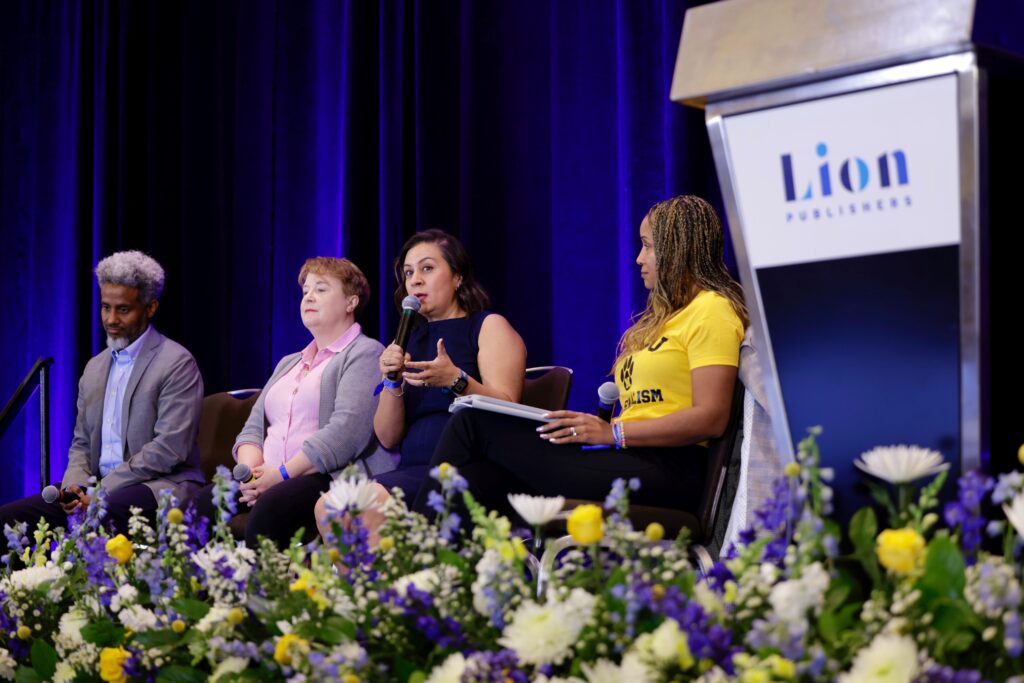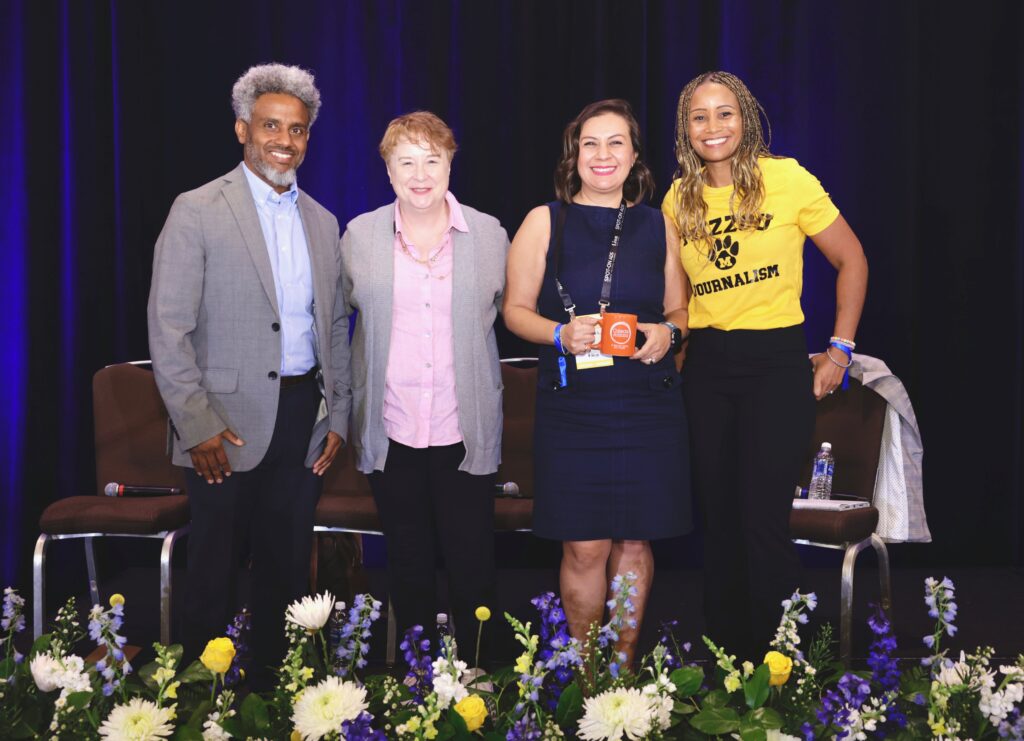
Henok Mengistu, founder and publisher of Ethiopique, Corinne Colbert, co-founder and editor in chief of the Athens County Independent, Maritza L. Félix, founder and director of Conecta Arizona, and Press Forward’s Graham Ringo at the LION Sustainability Summit. Credit: Fig Media
How can a newsroom best use $100,000?
Three Press Forward grantees discussed their real-world cases of using grants for long-term good last week during LION’s annual Independent News Sustainability Summit in St. Louis.
“A grant is a gift, but it’s also an opportunity,” Graham Ringo, Press Forward grantee engagement and support manager, said as she opened the panel.
The three grantees discussed the trade-offs between short- and long-term goals, as well as how they’re using $100,000 in unrestricted funding to strengthen their outlets post-grant period.
Here are three lessons the grantees – Corinne Colbert, co-founder and editor in chief of the Athens County Independent; Henok Mengistu, founder and publisher of Ethiopique LLC; and Maritza L. Félix, founder and director of Conecta Arizona — shared:
Leverage the grant for additional revenue
Receiving a high-profile grant can help a new outlet build credibility among readers and viewers — and with local funders. “To be able to say, ‘these people gave us money’ really helped a lot with a lot of the major funders [in our area],” Colbert said.
Mengistu experienced the same phenomenon, but with advertisers. “I had been begging advertisers before [the grant],” he said. “After we announced the news, there was a flood of advertisers coming to our door.”
But one — or several — grants aren’t enough to keep an outlet afloat and thriving. And the key to sustainability, Félix said, is asking for more. At Conecta Arizona, she’s worked to ask for what the outlet “deserves,” she said, and she’s always ready to show the results. She shares where every dollar goes and shows readers (and potential donors) how funding can have a real impact.
All three panelists stressed the importance of that transparency. After the Independent received its Press Forward Grant, Colbert wrote an editorial that said, in effect: We got this grant, but don’t close your wallets. Here’s what we’re going to use the money for — and, by the way, it’s going to go away in two years. Any time a news outlet can connect with its community and explain why it needs readers and supporters, it should. “We don’t tell our own stories enough,” Colbert said.

Henok Mengistu, founder and publisher of Ethiopique, Corinne Colbert, co-founder and editor in chief of the Athens County Independent, Maritza L. Félix, founder and director of Conecta Arizona, and Press Forward’s Graham Ringo at the LION Independent News Sustainability Summit. Credit: Fig Media
Set sustainable, long-term goals
Organizations hoping for a grant often have ideas about what they’d do with the money if they were to receive it. However, once a grant is issued, those initial plans don’t always hold up, especially as outlets look to the future and try to stretch the funding’s impact beyond the life of the grant.
When the Athens County Independent learned it was receiving its Press Forward grant, Colbert and the rest of the staff at the locally owned, community-driven news source thought they’d use the funds to raise pay and ensure everyone earned $40,000. After some debate, however, they realized there were competing needs. The staff ultimately decided to split the money: half went toward improved wages, raising salaries over $30,000, and the other half supported freelance work. “Having a living wage is a big part of sustainability,” Colbert said.
That same mindset guided their approach to organizational reserves. The Independent had built up savings from other local grants but had to dip into that money when they lost their development director. For Colbert, the decision to spend reserves on a role designed to replenish them was a clear return on investment.
The organization continues to maintain a healthy reserve runway—something she calls a critical milestone for such a young outlet. To her, reserves are not just a financial cushion but a strategic tool: deployed in key moments to stabilize operations, fuel capacity, and position the newsroom for long-term sustainability.
Mengistu, whose site serves the Ethiopian and Eritrean communities in the Washington, D.C. area, had a different outlook. He hired freelancers to help populate Ethiopique with more stories and also invested in equipment that he’ll be able to use for years to come.
While covering the 2024 Maryland Senate race, he arranged face time with the two candidates: Republican Larry Hogan and Democrat Angela Alsobrooks. For the interview with Hogan, Mengistu filmed on his phone. Then, using the Press Forward money, he invested in better recording equipment before his interview with Alsobrooks. Immediately, he noticed he was getting different, better treatment. “These are short-term opportunities that we expect to have a long-term impact down the road,” he explained.
Getting a grant doesn’t eliminate all obstacles or risk
An infusion of funds can immediately alleviate burdens and allow an organization to prepare for the future. Then the unexpected happens.
At Conecta Arizona, the current political climate has necessitated unexpected spending. A photographer was detained. A reporter faced hurdles while getting work papers renewed. Conecta Arizona, which covers communities on both sides of the U.S.-Mexico border, has used funds to pay for work visas and to help staffers negotiate a more secure status in the U.S. It has also purchased vests, masks, and goggles because reporters have been tear-gassed.
“Our community looks like us,” Félix said. “Our community is under attack.”
The key is to find a balance between short and long-term goals, Félix said.
“How do we invest now in the future but at the same time find joy in the purpose of doing so?” said Félix.
Joan Niesen is a freelance writer in St. Louis.

